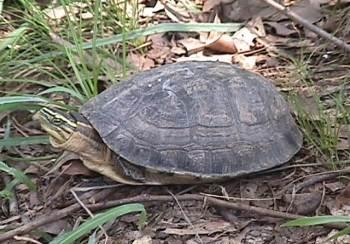Box Turtle - Indonesian
Malayan Box Turtle, Amboina, Asian Box Turtle Scientific Name: Cuora amboinensis
Sat, 14th June, 2025 - 6:40 pm GMT
Sponsor Ads:

Alternative Name
Malayan Box Turtle, Amboina, Asian Box Turtle Scientific Name: Cuora amboinensisBasic Info
Indonesian Box Turtles are moderately sized animals, rarely exceeding eight inches as mature adults. Adult Indonesian Box Turtles have a domed carapace (top of the shell), while younger specimens usually have a flattened carapace. There are three subspecies of Indonesian Box Turtles. Of these, Cuora amboinensis kamarona has the most highly domed shell, while the carapaces of Cuora amboinensis amboinensis and Cuora amboinensis cuoro are flatter and longer. The shell of the Indonesian Box Turtle ranges from dark olive to black in color and rarely has visible markings. The main distinguishing features of this species of turtle are the three yellow stripes on either side of its head.
Health
The Indonesian Box Turtle needs a large living area, at least 20-gallons. At least half of the tank should be a water area, with water at least as deep as the turtle is tall. The land area should have a warmer portion that can be used for basking. Rocks, wood and plants can be added, both to make the tank more attractive and to make the turtle more comfortable. The water temperature inside the tank must be between 80 and 85 degrees Fahrenheit (26.7-29.4 C). Colder temperatures will cause the animal to spurn the water, which can cause stress and other health problems. The air temperature within the tank should be 78 degrees Fahrenheit (25.6C) or higher, with a relative humidity of between 75 and 90 percent. Captive Indonesian Box Turtles can be fed greens, vegetable, fruits and mushrooms. While herbivorous in the wild, in captivity they can and will eat waxworms or crickets occasionally. The insects should be dusted with a nutritional supplement. Indonesian Box Turtles usually feed in the water and only need to be fed a couple times a week. Breeding Male Indonesian Box Turtles can be distinguished from females by their longer, wider tails and concave plastron. A breeding pair needs to be kept in a large enclosure, about 6' x 4', that is set up as much like a tropical rainforest as possible. Many breeders believe that the animals breed better if a "tropical winter" is simulated. The temperature along the equator does not decrease noticeably in the winter. The rain does stop for a while, during which time the turtles burrow and stop feeding regularly. If these conditions are mimicked in the enclosure for about six weeks, the turtles may breed more easily. After six weeks, the conditions should be returned to normal. Between two and four weeks later, the turtles will mate. Males are sometimes very aggressive during mating and should be carefully observed so they don't injure, or even kill, the female. After mating, the female Indonesian box Turtle will lay several clutches one every few weeks, containing one or two eggs. They usually lay their eggs between April and June. The eggs are white and about 1.5 inches long. The eggs usually hatch after between 70 and 85 days of incubation at temperatures between 82 and 85 degrees Fahrenheit.Habitat
Found in the wild in the equatorial rainforests of Southeastern AsiaBehavior
The Indonesian Box Turtle is also known as the Malayan Box Turtle, the Amboina, the Celebes Box Turtle, the Malaysian Box Turtle, the Siamese Box Turtle, the Vietnamese Box Turtle, the Southeast Asian Box Turtle and the Java Box Turtle. They are interesting animals and are common in captivity. Unlike other Asian Box Turtles, which are found in cooler regions of Asia, the Indonesian Box Turtle lives primarily in the equatorial rainforest and is used to warm, humid climates. They are primarily aquatic, one of the most aquatic of their genus. While the Indonesian Box Turtle will venture onto land, primarily to feed, they are most content while in the water. Indonesian Box Turtles can live quite a long time, usually between 30 and 35 years. Indonesian Box Turtles are quite curious, and dispels its curiosity with high activity. Indonesian box Turtles usually eat very well. In the wild, Indonesian Box Turtles are almost entirely herbivorous In their native habitat, the Indonesian Box Turtle is threatened because of destruction of habitat and predation by humans for food and for the medicinal properties the turtles are supposed to have. They are also disappearing from Asia because they are being caught and exported as pets. While many people feel this is good because it keeps the animals from being killed by other causes, the reality of the situation is that many wild-caught turtles die when introduced to captivity. This is because the turtles are often very badly cared for while in transit and in pet stores. The new owners of the turtles either do not do the research necessary to find out how to take care of their turtle or are given misleading information. Captive breeding and education of owners can produce animals that make excellent pets. Unfortunately, the Indonesian Box Turtle is not particularly easy to breed in captivity.Origin
Indo-PacificHistory
The Indonesian Box Turtle is only found in the wild in the equatorial rainforests of Southeastern Asia. They can be found in Thailand, Malaya, the Philippines, Southern Burma, South Vietnam and Indonesia. The three subspecies of Indonesian Box Turtles can be found in different parts of the range, and most of the turtles currently being exported as pets are from South Vietnam.Common Foods
. In captivity, however, they are omnivores, meaning they feed on both plant and animal matter. Indonesian Box Turtles often eat vegetables, greens and fruits in captivity and are sometimes offered waxworms or crickets.Sponsor Ads:
Insanity is part of the times. You must learn to embrace the madness; let it fire you. -- Londo, Babylon 5 to Vir Cotto
Box Turtle - Indonesian
Coded by: BGID® | ALL RIGHTS RESERVED Copyright © 2000-2025
Disclaimer | Privacy | Report Errors / Contact | Credits

 President of the United States of America - Real Estate mogul, Pageant owner and now one of the most controversial men in political history.
President of the United States of America - Real Estate mogul, Pageant owner and now one of the most controversial men in political history.  Global warming has been in and out as the "latest" hot topic for many years. It is, according to modern scientists, the result of man-made industrial pollutants, clearing forested areas, agriculture, etc. But now they are thinking it started way before the Industrial Revolution...
Global warming has been in and out as the "latest" hot topic for many years. It is, according to modern scientists, the result of man-made industrial pollutants, clearing forested areas, agriculture, etc. But now they are thinking it started way before the Industrial Revolution...  Politician, US Vice President and President of the USA - Joseph Robinette Biden Jr.
Politician, US Vice President and President of the USA - Joseph Robinette Biden Jr.  versus
versus  Russia: 'The Evil Empire'? Are they all that bad or is it just the USA trying to portray Russia as bad because they are a world power with land bigger and a society very different from the USA ideal?
Russia: 'The Evil Empire'? Are they all that bad or is it just the USA trying to portray Russia as bad because they are a world power with land bigger and a society very different from the USA ideal? 
 Corona virus
Corona virus 
 Users with wide screen monitors can benefit from more content on every page.
Users with wide screen monitors can benefit from more content on every page.